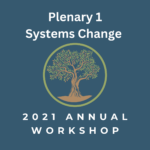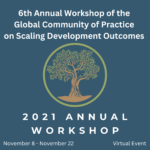By Irina Ivan with Cecilia Vaca Jones, Hague, The Netherlands, 16 July 2020
The Bernard van Leer Foundation (BvLF) has kept its focus on early childhood for more than 50 years. Since 1967, we have been working with and through partners in government, civil society, academia, and business to develop, scale and spread solutions that can be adapted and deployed worldwide, and which address multiple problems facing young children. While we have shifted our focus within this field over the course of this period, and we have also gradually started to work with more partners in government, the longevity of our sectoral focus has enabled us to learn a lot about what is necessary to go from promising small-scale pilots towards models and policies that can be scaled up to the national level or beyond.
We believe that a good start in life puts each child on the path to realizing her or his full potential and sets the foundation for a healthy, creative, and peaceful society. Collaboration across fields such as neuroscience, public health, education, and economics has resulted in the establishment of a firm fact – that when babies and toddlers have stable, responsive caregivers in safe, supportive environments, they can flourish even in the most difficult circumstances. Governments and other actors must therefore not only aim for universal policies and programs catering to all children but also ensure that the policies and programs focus on the most disadvantaged. In other words, we must work to level the playing field.
Over the years, we have seen amazing progress in the world of early childhood towards promoting a good start in life for all children. Plenty of ideas to improve the youngest children’s health, nutrition, protection, and learning have shown their worth. Political will for such ideas is now emerging worldwide. The case for WHY early childhood matters has effectively been made (for example by James Heckman, by Chuck Nelson, the Lancet, the New York Academy of Sciences, the Harvard Center for the Developing Child and Innovation for Poverty Action). While we have seen many of our programs scale over years (see links below), there remain challenges to be overcome with regard to HOW to deliver and sustain quality integrated approaches at scale. HOW do we effectively reach hundreds of thousands or millions of children with integrated policies? HOW do we continue to transition from good ideas to large-scale policies and programs that serve all children, especially the most vulnerable? And HOW do diverse actors operating at multiple levels collaborate more effectively?
One of the things we’ve learned is that our greatest asset is not our direct financial contribution. While over the past 50 years BvLF has worked in more than 50 countries and has invested over half a billion dollars of our own capital, we have leveraged many times that amount through additional funding from governments and other foundations. Since our inception, we have been thinking not only about how we invest – that is, identifying where the gaps are on the scaling pathway and seeking to fill those gaps – but also in ensuring that other actors can take up the baton and go that much further than us.
As part of our “blueprint for scale” investment decision-making progress, we regularly ask ourselves what we are learning about questions such as:
- How can we identify the most impactful and effective operating model at scale? We constantly look for ways to identify which specific, evidence-based components of programs are most impactful in communities with differing circumstances. We track which elements of urban, health, education, and social policies and practices for the early years are most effective. We are mindful that there are multiple pathways to scale, and that vertical and horizontal scaling processes need different approaches.
- How can we ensure effective intersectoral collaboration and coordination? Early childhood interventions implemented at scale need to span multiple sectors, such as nutrition, health, education, social protection, early learning and urban planning. We encounter different knowledge gaps, workforce gaps and implementation gaps in different countries. Effective collaboration takes time and effort to achieve.
- How can we develop effective short-term monitoring habits and integrated performance management systems? Operating early-years programs at scale requires good execution and flexibility. We need to identify the most meaningful indicators from hundreds of possibilities, build systems to analyze those indicators, enable course-correcting of processes or program content as needed, and integrate systems to enable children and caregivers to be referred towards the most appropriate support for their needs.
- How do we develop a robust understanding of costs across comparable interventions to better assess cost-effectiveness? To clearly understand what it takes to fund initiatives at scale, it is critical to try to disentangle the initial set-up costs of a program from the fixed and variable costs of running the intervention at scale with quality. It is important to identify ways to cost the various “program elements” so that we can look across comparable interventions in different geographies.
- How can we better integrate behavior change? Policies and programs achieve lasting impact only if they change human behaviors – of caregivers and service providers across a range of sectors, including health, nutrition, stimulation, discipline, mental health, use of public space and mobility. As behaviors are often deeply socially and culturally rooted, simplified and standardized approaches will not necessarily work across diverse contexts. We try to find the right mix of replication and innovation, developing models that can be adapted while providing space for emerging local solutions.
Working with partners, we have documented answers to these questions in a range of formats, including:
- The Beginning of Life documentary series, developed with Maria Farinha Films;
- Learning from BvLF’s Urban 95 partnerships documented by Princeton University Innovations for Successful Societies;
- Learning from BvLF’s Parents + partnerships documented by the Harvard Kennedy School;
- Learning from BvLF’s advocacy and coalitions partnerships, which bring together coalitions of national stakeholders to advocate for system-level change, documented by RAND Europe;
- Shorter summaries of the case studies are available on our website;
- Early learning: lessons from scaling up – a BvLF publication from
The most important element of scaling up can, however, be documented only through anecdotes, such as the powerful story we were told by one of our BvLF colleagues from a few years back. The colleague was visiting a parenting program in north-eastern Brazil, knocking on doors with one of the program’s home visitors, at a time when the Zika virus was causing a birth defect called microcephaly. One new mother told him how happy she was to have been repeatedly visited by the home visitor because her friends and relatives, feeling embarrassed, had not been coming to visit her, and she had been feeling lonely and isolated. The home visitor had brought her what all humans need most: the feeling of being seen, valued and loved. The more tangible elements of scaling early-years programs – intersectoral collaboration, monitoring systems, and so on – ultimately serve the purpose of reaching all caregivers who need support, whether knocking on their doors directly or building systems that help them to gather together to share their concerns and challenges and overcome feelings of isolation. The biggest “how” question of all is how to scale up love and the human touch.


